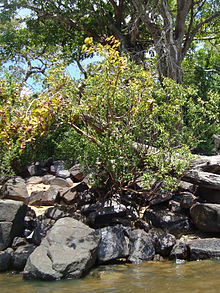Camu Camu
| Myrciaria dubia | |
|---|---|
 |
|
| Scientific classification | |
| Kingdom: | Plantae |
| (unranked): | Angiosperms |
| (unranked): | Eudicots |
| (unranked): | Rosids |
| Order: | Myrtales |
| Family: | Myrtaceae |
| Genus: | Myrciaria |
| Species: | M. dubia |
| Binomial name | |
|
Myrciaria dubia (Kunth) McVaugh |
|
| Synonyms | |
|
|
Myrciaria dubia, commonly known as camu camu, camucamu, cacari, or camocamo, is a small bushy riverside tree from the Amazon rainforest in Peru and Brazil, which grows to a height of 3–5 m (9.8–16.4 ft) and bears a red/purple cherry-like fruit. It is a close relative of the jabuticaba (Myrciaria cauliflora) and the guavaberry or rumberry (Myrciaria floribunda). The high vitamin C content, on the order of 2–3% of fresh weight, is the most important property of the fruit.
Camu camu has small flowers with waxy white petals and a sweet-smelling aroma. It has bushy, feathery foliage. The evergreen, opposite leaves are lanceolate to elliptic. Individual leaves are 3–20 cm (1.2–7.9 in)m in length and 1–2 cm (0.39–0.79 in) wide.
The current range of camu camu consists of the Amazonian lowlands of Colombia, Ecuador, Peru, Bolivia, and Brazil. Its distribution extends from the center of Pará state, Brazil, along the mid and upper Amazon River to the eastern part of Peru; in the north, it appears in the Casiquiare and the upper and middle Orinoco River. In Brazil, it is found in Rondônia along the Maçangana and Urupa Rivers and in Amazonas, in the municipalities of Manaus and Manacapuru and along the Javarí, Madeira, and Negro Rivers.
...
Wikipedia
